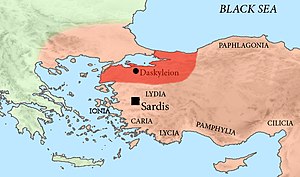
Megabyzus was an Achaemenid Persian general, son of Zopyrus, satrap of Babylonia, and grandson of Megabyzus I, one of the seven conspirators who had put Darius I on the throne. His father was killed when the satrapy rebelled in 482 BCE, and Megabyzus led the forces that recaptured the city, after which the statue of the god Marduk was destroyed to prevent future revolts. Megabyzus subsequently took part in the Second Persian invasion of Greece. Herodotus claims that he refused to act on orders to pillage Delphi, but it is doubtful such orders were ever given.
Artabazos was a Persian general in the army of Xerxes I, and later satrap of Hellespontine Phrygia under the Achaemenid dynasty, founder of the Pharnacid dynasty of satraps. He was the son of Pharnaces, who was the younger brother of Hystaspes, father of Darius I. Artabazos was therefore a first cousin of the great Achaemenid ruler Darius I.
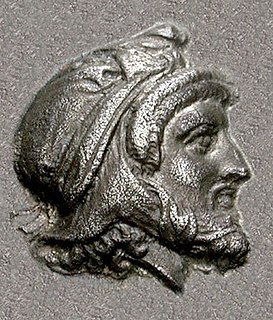
Pharnabazus II was a Persian soldier and statesman, and Satrap of Hellespontine Phrygia. He was the son of Pharnaces II of Phrygia and grandson of Pharnabazus I, and great-grandson of Artabazus I. He and his male ancestors, forming the Pharnacid dynasty, had governed the satrapy of Hellespontine Phrygia from its headquarters at Dascylium since 478 BC. He married Apama, daughter of Artaxerxes II of Persia, and their son Artabazus also became a satrap of Phrygia. According to some accounts, his granddaughter Barsine may have become Alexander the Great's concubine.

Artaphernes, flourished circa 513–492 BC, was a brother of the Achaemenid king of Persia, Darius I, satrap of Lydia from the capital of Sardis, and a Persian general. In his position he had numerous contacts with the Greeks, and played an important role in suppressing the Ionian Revolt.

Histiaeus, the son of Lysagoras, was a Greek ruler of Miletus in the late 6th century BC. Histiaeus was tyrant of Miletus under Darius I, king of Persia, who had subjugated Miletus and the other Ionian states in Asia Minor, and who generally appointed Greeks as tyrants to rule the Greek cities of Ionia in his territory.
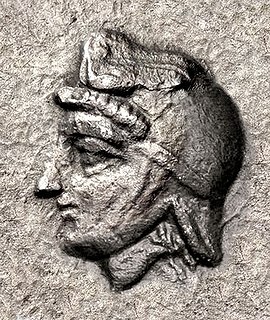
Autophradates was a Persian Satrap of Lydia, who also distinguished himself as a general in the reign of Artaxerxes III and Darius III.
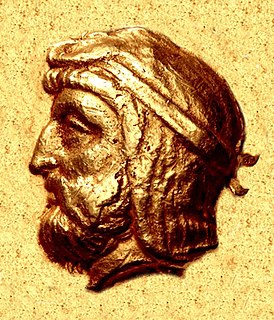
Artabazos II was a Persian general and satrap of Hellespontine Phrygia. He was the son of the Persian satrap of Hellespontine Phrygia Pharnabazus II, and younger kinsman of Ariobarzanes of Phrygia who revolted against Artaxerxes II around 356 BC. His first wife was an unnamed Greek woman from Rhodes, sister of the two mercenaries Mentor of Rhodes and Memnon of Rhodes. Towards the end of his life, he became satrap of Bactria for Alexander the Great.

Megabazus, son of Megabates, was a highly regarded Persian general under Darius, to whom he was a first-degree cousin. Most of the information about Megabazus comes from The Histories by Herodotus.

The Satrapy of Lydia, known as Sparda in Old Persian, was an administrative province (satrapy) of the Achaemenid Empire, located in the ancient kingdom of Lydia, with Sardis as its capital.

Tabalus the Persian was the first satrap of Sardis. Cyrus the Great of Persia put him in place after conquering Lydia, c.546 BC. Herodotus mentions him in his histories :
Presently, entrusting Sardis to a Persian called Tabalus, and charging Pactyes, a Lydian, to take charge of the gold of Croesus and the Lydians, he himself marched away to Agbatana, taking with him Croesus, and at first making no account of the Ionians. For he had Babylon on his hands and the Bactrian nation and the Sacae and Egyptians; he was minded to lead an army himself against these and to send another commander against the Ionians.
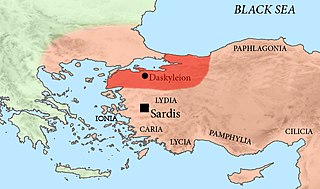
Dascylium, Dascyleium, or Daskyleion, also known as Dascylus, was a town in Anatolia some 30 kilometres (19 mi) inland from the coast of the Propontis, at modern Ergili, Turkey. Its site was rediscovered in 1952 and has since been excavated.

The Pharnacid dynasty was a Persian dynasty that ruled the satrapy of Hellespontine Phrygia under the Achaemenid Dynasty from the 5th until the 4th century BCE. It was founded by Artabazus, son of satrap Pharnaces I, son of Arsames. They were directly related to the Achaemenid dynasty itself. The last member of the dynasty was Pharnabazus III.

Pharnaces II ruled the satrapy of Hellespontine Phrygia under the Achaemenid Dynasty of Persia. Hellespontine Phrygia comprised the lands of Troad, Mysia and Bithynia and had its seat at Daskyleion, south of Cyzicus, Mysia.
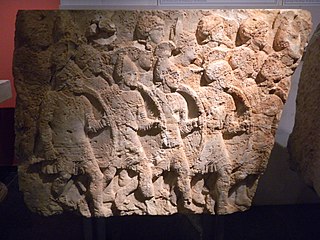
The Great Satraps' Revolt, or the Revolt of the Satraps, was a rebellion in the Achaemenid Empire of several satraps against the authority of the Great King Artaxerxes II Mnemon. The Satraps who revolted were Datames, Ariobarzanes and Orontes of Armenia. Mausolus the Dynast of Caria participated in the Revolt of the Satraps, both on his nominal sovereign Artaxerxes Mnemon's side and (briefly) against him.

Hellespontine Phrygia or Lesser Phrygia was a Persian satrapy (province) in northwestern Anatolia, directly southeast of the Hellespont. Its capital was Dascylium, and for most of its existence it was ruled by the hereditary Persian Pharnacid dynasty. Together with Greater Phrygia, it made up the administrative provinces of the wider Phrygia region.

Bagaeus, son of Artontes, was an Achaemenid nobleman, who was ordered by Darius I to kill the rebellious satrap of Lydia, Oroetes. Oroetes was accused of having killed Mitrobates, the satrap of Daskyleion and his son, but is best known as the murderer of Polycrates of Samos. Herodotus recounts how Bagaeus used written orders from Darius in order to assure himself of the obedience of the bodyguards of Oroetes to the orders of Darius, and when assured, produced a final order to kill Oroetes:
So when Darius became king, he wanted to punish Oroetes for all his wrongdoing, and especially for killing Mitrobates and his son. But he thought it best not to send an army openly against the satrap, seeing that everything was still in confusion and he was still new to the royal power; moreover he heard that Oroetes was very powerful, having a guard of a thousand Persian spearmen and being governor of the Phrygian and Lydian and Ionian province. He had recourse, then, to the following expedient: having summoned an assembly of the most prominent Persians, he addressed them as follows: “Persians, which of you will promise to do this for me, not with force and numbers, but by cunning? Where there is need for cunning, force has no business. So then, which of you would either bring me Oroetes alive or kill him? For he has done the Persians no good, but much harm; he has destroyed two of us, Mitrobates and his son, and is killing my messengers that are sent to recall him, displaying an insolence that is not to be borne. So, then, before he does the Persians some still greater harm, he has to be punished by us with death.” Darius asked this and thirty men promised, each wanting to do it himself. Darius told them not argue but draw lots; they did, and the lot fell to Bagaeus, son of Artontes. Bagaeus, having drawn the lot, did as follows: he had many letters written concerning many things and put the seal of Darius on them, and then went with them to Sardis.

Mitrobates ; was an Achaemenid satrap of Daskyleion under the reigns of Cyrus the Great, who nominated him for the role, and Cambyses. After Cambyses died, and during the struggles for succession that followed, he is said to have been assassinated, together with his son Cranaspes, by the neighbouring satrap of Lydia, Oroetes, who wanted to expand his Anatolian territories. After the assassination, Oroetes added the territory of Hellespontine Phrygia to his own.
After Cambyses had died and the Magians won the kingship, Oroetes stayed in Sardis, where he in no way helped the Persians to regain the power taken from them by the Medes, but contrariwise; for in this confusion he slew two notable Persians, Mitrobates, the governor from Dascyleium, who had taunted him concerning Polycrates, and Mitrobates' son Cranaspes; and besides many other violent deeds, when a messenger from Darius came with a message which displeased him, he set an ambush by the way and killed that messenger on his journey homewards, and made away with the man's body and horse. So when Darius became king he was minded to punish Oroetes for all his wrongdoing, and chiefly for the killing of Mitrobates and his son.

The Achaemenid destruction of Athens was accomplished by the Achaemenid Army of Xerxes I during the Second Persian invasion of Greece, and occurred in two phases over a period of two years, in 480–479 BCE.

Otanes, son of Sisamnes, was an Achaemenid judge and later Satrap of Ionia during the reign of Darius the Great, circa 500 BC.

Bubares was a Persian nobleman and engineer in the service of the Achaemenid Empire of the 5th century BC. He was one of the sons of Megabazus, and a second-degree cousin of Xerxes I.
